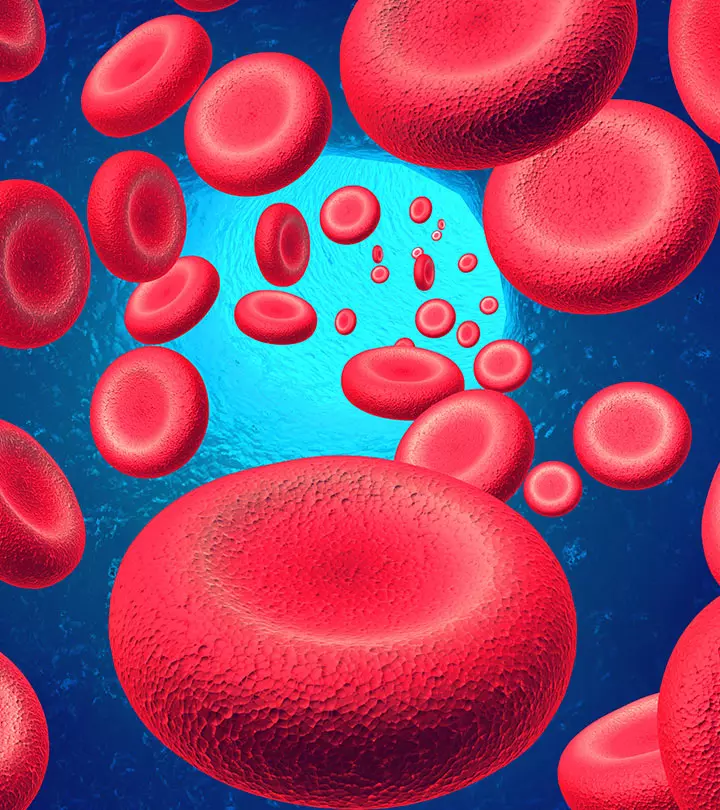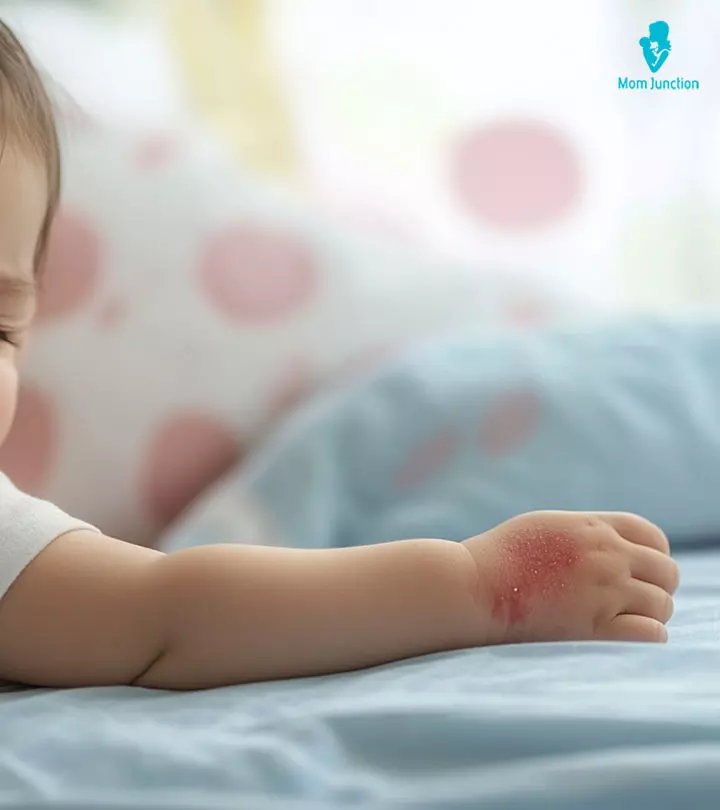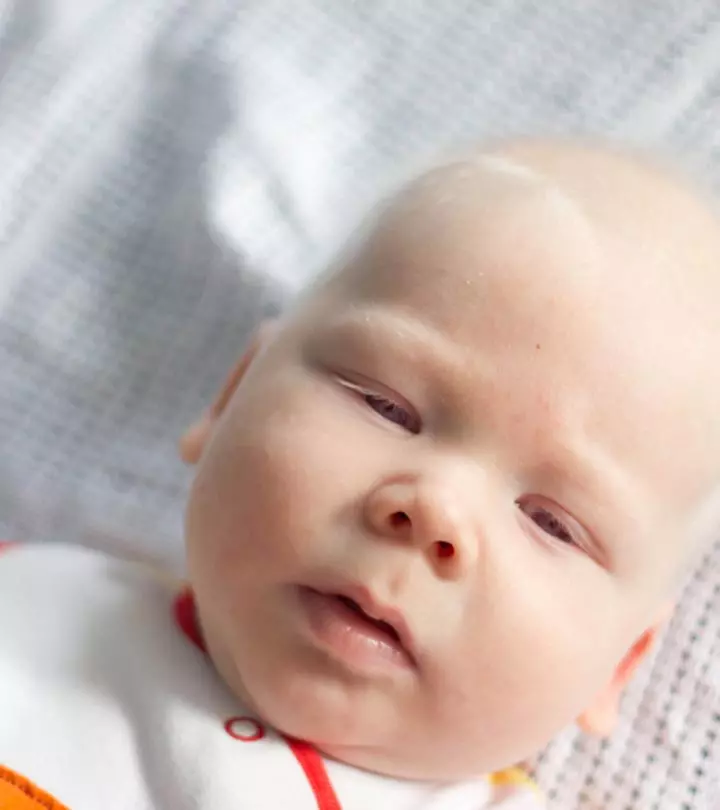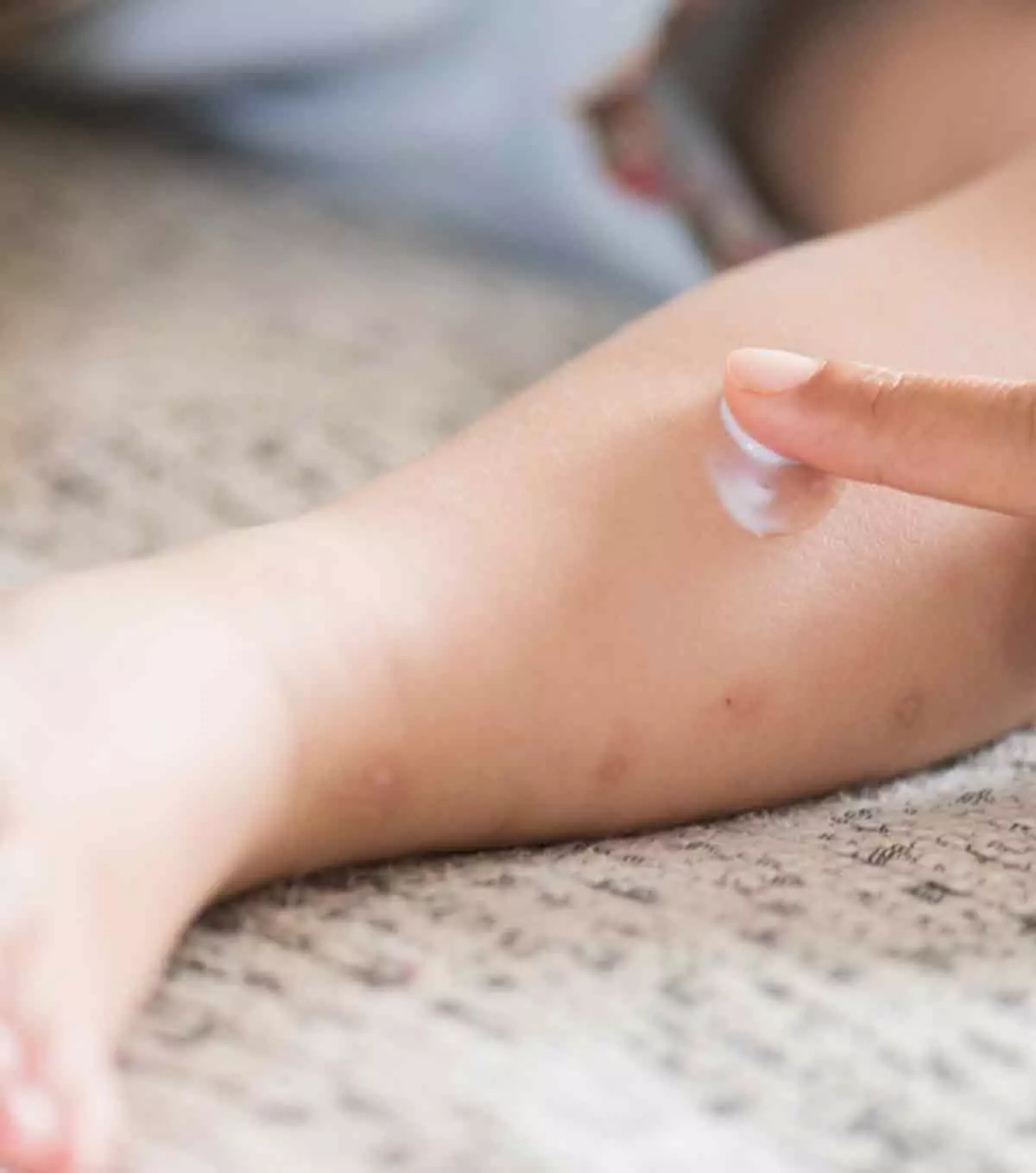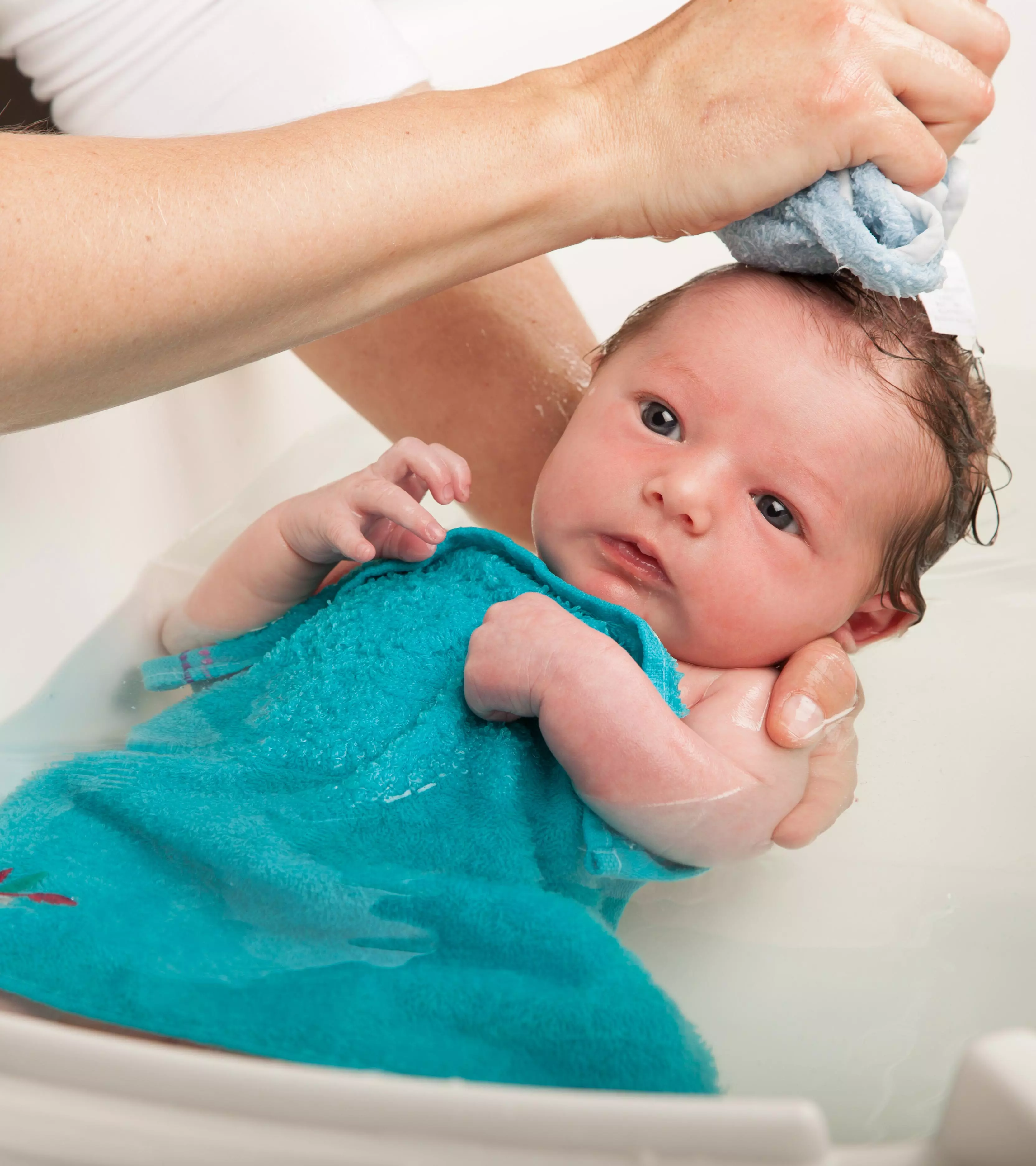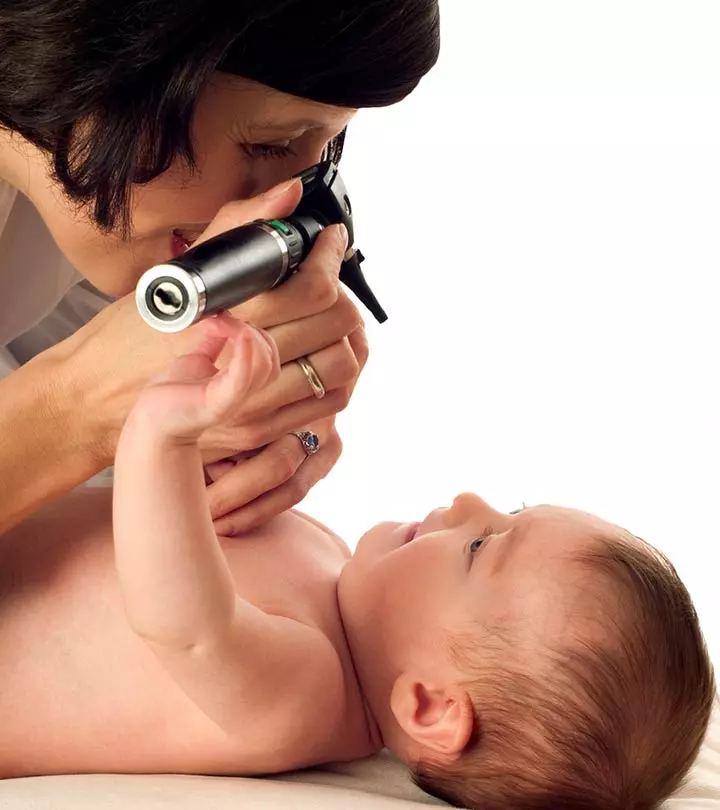
Image: Shutterstock
Babies have delicate eyes that may get irritated easily (1) Irritated eyes may present as redness around the baby’s eyes or itching in the eyes. For most children, the redness subsides by itself without any medical intervention. However, it is important to contact your child’s pediatrician if you notice any other signs of eye irritation, such as watery eyes or sticky discharge.

Read this post to learn more about the causes, home remedies, and treatment for redness around the baby’s eyes. Please note, this post is for informational purposes only and should not be considered medical advice. Please consult a healthcare professional for personalized care.
Key Pointers
- Vigorous eye rubbing, allergies, conjunctivitis, sty, etc., are some reasons children may have redness around their eyes.
- Warm compresses, moisturizers, and mild soaps help manage redness around a baby’s eyes.
- Your doctor might prescribe antibiotics, probe surgeries, etc., based on the underlying cause to treat redness around the eyes.
Causes Of Redness Around Baby’s Eyes
Redness under the eyes in infants could be due to an irritant, infection, or tear duct blockage. A blocked tear duct or irritant should resolve by itself with minor remedies. If the cause is an infection, causing discharge and pain, you should visit a pediatrician.
Dr. Yuna Rapoport, MD, MPH, a US-based board-certified and fellowship-trained ophthalmologist, says, “Redness around the eyes in a baby is usually mild, like contact dermatitis. It may go away on its own or sometimes need an over-the-counter steroid ointment or a lubricating ointment.
“Occasionally, redness around the eyes in a baby may be an infectious condition such as preseptal cellulitis or orbital cellulitis, which have to be treated with antibiotics. In rare cases, redness around the eyes may mean a rare malignant tumor such as retinoblastoma. If the redness presents suddenly and is only in one eye, this rare entity should be ruled out.”
Since babies have extremely sensitive skin and eyes, they are prone to react to any substance instantly. Some possible reasons causing redness around your baby’s eyes are as follows:
- Rubbing: If your baby or toddler has a habit of rubbing their eyes frequently, this might be the cause of the redness around their eyes. It is usually not a reason for concern and can probably resolve by itself.
 Be watchful
Be watchful
- Allergies: Histamine is usually released from the baby’s eyes when they contact an allergen (2). Due to this, there might be visible redness and swelling surrounding the eyes. It might also lead to watery discharge from the eyes. Environmental factors such as pollen, dust, and pet dander often cause allergies, leading to redness around the eyes.
- Eye Infections: Exposure to bacteria or viruses can cause infections in a baby’s eyes.
- Viral conjunctivitisiInfection or inflammation of the transparent membrane that covers eyelids and eyeball : The most common viruses causing conjunctivitis in babies are AdenovirusiA virus that can infect the eyes, gastrointestinal tract, and respiratory tract and Herpes virus. It causes redness in and around the eyes or pink eye in babies (3).
- Bacterial conjunctivitis: Bacterial conjunctivitis is commonly caused by Haemophilus influenzae or Streptococcus pneumoniae. The symptoms include periorbital cellulitisiThe space between the skin of the eyelid and the bony region that surrounds the eye and redness around the pupil. In some cases, white or yellow discharge is seen.
- Newborn conjunctivitis: This type of conjunctivitis occurs when the baby is exposed to certain harmful viruses or bacteria in the birth canal during delivery. According to the Centers For Disease Control And Prevention (CDC), it may be caused due to irritation or a blocked tear duct and leads to eye discharge (4). Therefore, whether or not your newborn is showing any signs of eye infections, the American Academy of Pediatrics (AAP) suggests treating all newborns with antibiotic eye ointment or drops in the delivery room to prevent any serious complications later (5).
- Impetigo contagiosa: It is another bacterial infection caused by Staphylococcus aureus or Streptococcus pyogenes that occurs rarely in babies over two months of age. These bacteria cause blisters that burst, forming reddish crusts on the face (around the nose and mouth), soft tissue regions, and the extremities. As a contagious infection, this may spread to the baby from another infected person, such as the mother or other children around the infant (6). A study published in the American Academy of Family Physicians (AAFP) found that impetigo is one of the most common skin infections in children aged two to four years (7). Impetigo contagiosa may also turn into an eye infection by causing crusts on the baby’s eyelids, especially if the baby touches their eyes with the same hand, cloth, or other objects that have touched their infected skin (6) (7) (8).
- Sty: A sty is a painful lump near the edge of the eyelid and is often filled with pus (9). It looks like a boil or pimple and develops due to the blockage of the small drainage glands lining the eyelids.
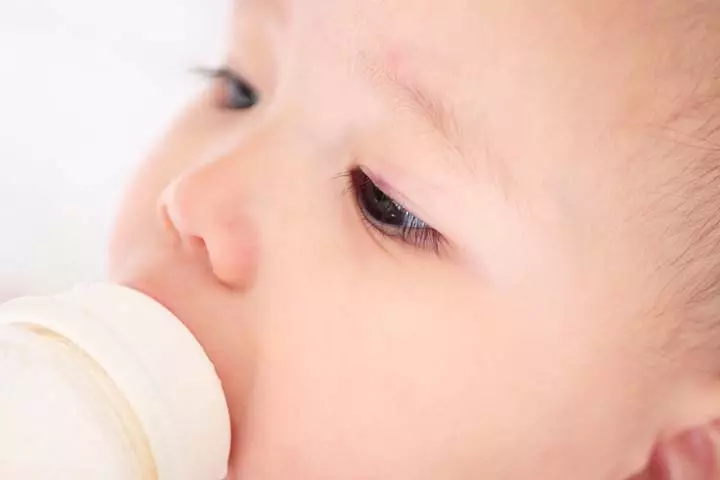
- Periorbital cellulitis: Periorbital cellulitis is a skin infection affecting the eyelids. It can be caused due to an insect or animal bite or due to conjunctivitis. If the infection reaches the inner areas of the eyelids, it is known as orbital cellulitis (10) and might lead to serious repercussions.
- Cleaning and hygiene products: Babies have soft and sensitive skin that can react to the slightest exposure to harmful or harsh chemicals (1). If the shampoo, soap, or any other product contains such substances, it can cause reactions, such as redness and irritation around the circumferential area of the eyes.
- Dry/dehydrated skin: Another possible reason for redness around the eye area may be due to the skin being dehydrated and lacking in moisture.
Medical expert Dr. Po-Chang Hsu says, “A few key signs can help distinguish between mild irritation and a more serious issue. If your baby is unusually fussy, frequently rubs their eyes, or has excessive tearing, it may be more than a mild reaction. Additional symptoms like redness, sensitivity to light, swelling, or difficulty keeping their eyes open could indicate an infection or inflammation that needs prompt medical attention.”
A pediatric ophthalmologist or pediatrician can help determine the root cause of the redness around a baby’s eyes and provide suitable treatment options after conducting a thorough physical evaluation and reviewing the medical history.
 Quick fact
Quick factHome Remedies For Red Rash Around Baby’s Eyes
If you notice redness around your baby’s eyes, you can start home treatment after consulting with the baby’s pediatrician.

- Change your baby’s soap to a mild and gentle one with no harsh chemicals.
- Apply moisturizers to help prevent dryness of the skin (1).
- Use a warm compress (a soft cloth dipped in warm water) if the redness around the eyes is accompanied by pain and swelling. It can help soothe the pain and clean the crust and fluid discharge around the eyes.
- Apply cold compresses (a clean and soft cloth dipped in cool water) to the eyes to reduce swelling and puffiness (11).
- Try a gentle, warm massage between the eyes and nose. It can help in the case of blocked tear ducts that can cause eye redness in babies (11).
Some studies suggested that breast milk as eye drops may be considered an initial treatment option for infants six months old or younger with eye discharge (12).
Allana, a mother of three, shares how she treated her six-month-old baby’s pink eye with breastmilk. She says, “My youngest Jayce had been sick with a nasty cold for a few weeks, and one morning when he woke up, his right eye looked a little irritated (NOT pink), and throughout the day, it got worse and worse…
“Then the green slimy gunk came. And I thought…hmmm pink eye? Right away, I pulled up an old text I had sent a friend with a link on natural pink eye treatments a few weeks back, “I knew Brest milk was on the list, and since I had a bag in the freezer, I got it out and started with that. I put it in my eye first! I would never do anything to my babies if I hadn’t tried first (i).”
 Quick tip
Quick tipBesides these, the American Academy of Pediatrics (AAP) recommends avoiding direct contact with your child’s eyes or eye discharge until redness in and around the eyes is clear (5).
Treatment For Redness Around Baby’s Eyes

If the redness encircling the eyes persists for more than a few days and is accompanied by fever, or you notice swelling or discharge from the eyes, it is advisable to consult your doctor as soon as possible. Some of the probable treatment measures are as follows (11) (13) (14) (15):
- Preservative-free artificial tears can help prevent dry eyes and eye allergies (16).
- Ibuprofen and other over-the-counter pain relief options can provide helpful relief. However, avoid giving these medications to babies aged less than six months.
- Oral antibioticsi can help treat bacterial conjunctivitis, especially chlamydial conjunctivitis in newborns.
- Antibiotic eye drops or ointments can relieve painful or swollen baby eyes and reduce redness in case of a bacterial infection or conjunctivitis.
- Pink or red eyes in babies caused by viruses often do not require any treatment and heal on their own in one to two weeks.
- Simple probe surgery if the blocked tear duct is not cleared in babies reaching one year.
- Antibiotics through IV; however, this is rare in cases of cellulitis and gonococcal conjunctivitis.
Ways To Prevent Redness Around Baby’s Eyes
Here are some simple yet effective ways that can help prevent or control baby red around the eyes (11) (17):
- Cover your baby’s hands with mittens if they rub their eyes frequently. It can help prevent scratches and reduce the frequency of rubbing.
- Avoid the use of substances that might act as allergens for your baby.
- Wash your hands properly before and after handling the baby.
- Disinfect your house regularly and sanitize blankets, toys, and surfaces properly.
- Wash and keep your baby’s bedding and clothes separately.
- Keep the baby away from an infected individual.
- If you’re pregnant and have an STD, discuss with your doctor to prevent pink eye in your baby.
Frequently Asked Questions
1. Can a lack of sleep cause redness around the eyes in babies?
A lack of sleep may cause the baby to rub their eyes, resulting in redness around the eyes. However, it should resolve after proper sleep.
2. Can a baby’s red eyes be contagious?
If the redness is due to allergies, sty, a blocked duct, or baby rubbing eyes, then it is not contagious. However, it is contagious if the cause is a bacterial or viral infection (infective conjunctivitis).
3. Can teething cause redness around a baby’s eyes?
No, teething is not found to be a usual cause of redness around a baby’s eyes.
4. Can a baby’s red eyes indicate a food allergy?
Yes, food allergies may cause red, itchy, and watery eyes in babies. Other accompanying symptoms may include sneezing, blocked or runny nose, itchy skin rash, and wheezing or coughing (19).
Redness around a baby’s eye may be concerning for any parent. Redness may occur due to something as simple as rubbing or scratching to something more serious. Your doctor may help you diagnose the underlying cause, if any. Do not try home remedies without consulting your doctor because the eyes are a vital organ. The redness mostly subsides by itself in a few days. If you notice accompanying signs such as fever or swelling that does not reduce or worsen, you should consult a pediatrician to rule out other infections.
Infographic: Baby Eye Care Tips
Your baby’s eyes are sensitive, and they need good care for proper vision development. Check out these simple yet effective baby eye care tips to help avert eye problems in babies. Save this infographic and share it with every new mom you know.
Some thing wrong with infographic shortcode. please verify shortcode syntax
Personal Experience: Source
MomJunction articles include first-hand experiences to provide you with better insights through real-life narratives. Here are the sources of personal accounts referenced in this article.
i. PINK EYE…from in the dark into the light;https://medium.com/@kailuamom3/pink-eye-from-in-the-dark-into-the-light-6e5df54921a4
References
- Bathing and skincare for the newborn.
https://www.stanfordchildrens.org/en/topic/default?id=bathing-and-skin-care-for-the-newborn-90-P02628 - Allergies: Types Symptoms Causes and Treatment.
https://my.clevelandclinic.org/health/diseases/8610-allergies - Pink Eye (Conjunctivitis).
https://my.clevelandclinic.org/health/diseases/pink-eye-conjunctivitis - Conjunctivitis in Children.
https://www.stanfordchildrens.org/en/topic/default?id=conjunctivitis-in-children-90-P02078 - Eye Infections in Infants & Children
https://www.healthychildren.org/English/health-issues/conditions/eyes/Pages/Eye-Infections.aspx - Deepak Sharma et al.; (2014); Impetigo contagiosa: an interesting and a very rare finding in a newborn.
https://pmc.ncbi.nlm.nih.gov/articles/PMC4024522/ - HOLLY HARTMAN-ADAMS et al.; (2014); Impetigo: Diagnosis and Treatment.
https://www.aafp.org/pubs/afp/issues/2014/0815/p229.html - Eyelid Problems.
https://www.healthychildren.org/English/health-issues/conditions/eyes/Pages/Eyelid-Problems.aspx - Sty.
https://www.seattlechildrens.org/conditions/a-z/sty/ - William N Clarke; (2004); Periorbital and orbital cellulitis in children.
https://www.ncbi.nlm.nih.gov/pmc/articles/PMC2720862/ - Pink Eye in Newborns.
https://www.nei.nih.gov/learn-about-eye-health/eye-conditions-and-diseases/pink-eye/pink-eye-newborns - Tetsu Sugimura et al.; (2025); Efficacy and safety of breast milk eye drops in infants with eye discharge
https://pubmed.ncbi.nlm.nih.gov/33098117/ - Pink Eye in Newborns.
https://www.cdc.gov/conjunctivitis/newborns/?CDC_AAref_Val=https://www.cdc.gov/conjunctivitis/newborns.html - Conjunctivitis in babies children and teens.
https://raisingchildren.net.au/guides/a-z-health-reference/conjunctivitis - Quick Home Remedies for Pink Eye.
https://www.aao.org/eye-health/diseases/pink-eye-quick-home-remedies - Eye Drops For Children.
https://www.optometrists.org/childrens-vision/guide-to-childrens-eye-exams/eye-drops-for-children// - Pinkeye (Conjunctivitis)
https://www.healthychildren.org/English/health-issues/conditions/eyes/Pages/PinkEye-Conjunctivitis.aspx - Cradle Cap (Seborrheic Dermatitis in Infants).
https://my.clevelandclinic.org/health/diseases/15786-cradle-cap-seborrheic-dermatitis-in-infants - Food allergies in babies and young children.
https://www.nhs.uk/conditions/baby/weaning-and-feeding/food-allergies-in-babies-and-young-children/
Community Experiences
Join the conversation and become a part of our nurturing community! Share your stories, experiences, and insights to connect with fellow parents.
Read full bio of Dr. Garima Garg Seth
- Dr. Yuna Rapoport is a board-certified and fellowship trained ophthalmologist, who did her medical degree at Northwestern University and ophthalmology residency at Vanderbilt Eye Institute in Nashville, Tennessee. She then obtained additional training as a corneal and refractive surgery fellow from the Massachusetts Eye and Ear Infirmary of Harvard Medical School. Dr. Rapoport has been in private practice in New York City for over five years.
 Dr. Yuna Rapoport is a board-certified and fellowship trained ophthalmologist, who did her medical degree at Northwestern University and ophthalmology residency at Vanderbilt Eye Institute in Nashville, Tennessee. She then obtained additional training as a corneal and refractive surgery fellow from the Massachusetts Eye and Ear Infirmary of Harvard Medical School. Dr. Rapoport has been in private practice in New York City for over five years.
Dr. Yuna Rapoport is a board-certified and fellowship trained ophthalmologist, who did her medical degree at Northwestern University and ophthalmology residency at Vanderbilt Eye Institute in Nashville, Tennessee. She then obtained additional training as a corneal and refractive surgery fellow from the Massachusetts Eye and Ear Infirmary of Harvard Medical School. Dr. Rapoport has been in private practice in New York City for over five years. 
Dr. Po-Chang Hsu is a medical doctor and medical content expert. He received his medical degree from Tufts University School of Medicine in Boston in 2016. Previously, he did a master’s degree at Harvard University and wrote a thesis on neuroimaging in schizophrenia patients at Brigham and Women’s Hospital. He currently works at Alpas Wellness.
Dr. Po-Chang Hsu is a medical doctor and medical content expert. He received his medical degree from Tufts University School of Medicine in Boston in 2016. Previously, he did a master’s degree at Harvard University and wrote a thesis on neuroimaging in schizophrenia patients at Brigham and Women’s Hospital. He currently works at Alpas Wellness.
Read full bio of Sanjana Bhattacharjee
Read full bio of Siddharth Kesiraju
Read full bio of Vidya Tadapatri





